So, Buffett’s annual letter to shareholders came out. What can I say? Berkshire (BRK) is an incredible money making machine. They grew book 18.2% after some meaningless charges. Yes, that’s not so exciting compared to the S&P 500 index, but for a $200+ billion giant, it’s pretty darn good. And this is not too far from some high fee hedge funds (that I even like).
Anyway, here are some thoughts as I read the annual report. I’ll just cut and paste some stuff and talk about things that came to mind as I read.
First, here is the table of BRK’s book value per share (BPS) growth in certain time periods. The first column is the BPS growth, the second column is the S&P 500 index. I just cut out some years of particular interest.
Check out the two different time periods below. The first period is 1982-1999, a period of a really strong, historical bull market. This is one of the biggest bull markets of all time. BRK is designed, I think, to outperform over the long term, but not necessarily in the really strong years. But the table below shows that BRK actually underperformed the S&P 500 index only once during the entire bull market. Even in the go-go 1980’s, BRK outperformed every single year. The time period I was mostly interested in, though, was the period between 1995 and 1999. I don’t have a table handy, but I think this was one of the strongest runs in the stock market ever. And look, BRK only underperformed in one single year in 1999. That is just absolutely mind-boggling.
And here is what I was interested in. Compare the time period between 1995-1999 with the recent run in the S&P 500 index over the past five years. This is nothing compared 1995-1999, but it still was a pretty strong run.
In this more recent time period, BRK underperformed the index in four of those five years. Not only that, but it has underperformed the index over these five years. Looking at the whole time period between 2000 and 2013, BRK lagged the stock market in six of those fourteen years.
So what’s going on? BRK is supposed to outperform over time, but do better in normal to weak environments and lag in super strong markets. But this table shows that BRK outperformed in super strong markets in the past, but now lags more often in this choppy, flattish market.
But of course, the important thing is how much BRK outperforms over time, not the number of years it outperforms.
Let’s look at the performance / outperformance of these two time periods:
BRK S&P 500 Relative
BPS growth w/dividends performance
1982 – 1999 +26.1%/year +18.3%/year +7.8%/year
2000 – 2013 +9.7%/year +4.7%/year +5.0%/year
So despite underperforming the market six times in the last fourteen years, BRK managed to outperformed by 5.0%/year overall. That’s the more important figure, of course.
But still, I was curious about this so I went back to see how BRK was more of a leveraged stock market play compared to today.
Here’s what I mean. Check out this table:
BRK equity BRK shareholders
portfolio (A) equity (B) (A)/(B)
1994 $15.2 $11.9 1.28x
1995 $22.0 $17.2 1.28x
1996 $27.8 $23.4 1.20x
1997 $36.2 $31.5 1.15x
1998 $39.8 $57.4 0.7x
So if you were looking at BRK as an investment candidate and wondered how BRK would do over time, you would have noticed that it is an amazing investment vehicle.
The equity portfolio was 1.3x BRK’s shareholders’ equity. When you model the potential BPS growth over time, you can plug in an assumption that the stock market will go up 10% over time. So just from that, right there, you would have a 13% pretax return on equity baked in the cake. That’s 13% just from the equity portfolio alone with 1.3x leverage (to net worth).
And you know that Buffett is a great investor so can expect more than that. With a 15% expected stock market return (or return on Buffett’s picks), that would have given you a close to 20% pretax return right there, before even looking at the other businesses.
When you look at it that way, it’s no wonder why BRK blew away the S&P 500 index year after bullish, bubbly year in the 1990s.
After the Gen Re acquisition, this ratio went down dramatically. Gen Re added a lot of float, and a lot of that float had to be invested in bonds and cash for regulatory purposes.
As of the end of 2013, this equity market leverage is around 0.5x or 0.6x if you include “other” and the Heinz position which is equity and equity-like securities.
So this is obviously one major factor that contributes to BRK underperforming the strong up stock markets (as compared to the 1990s).
But is this bad? For equity investors who like equity returns and like it more when leveraged equity returns can be had via BRK-like structures, maybe it’s not so exciting.
We have to remember, though, that this ratio is misleading. For example, BRK over time has purchased all of GEICO and all of Burlington Northern. Does it make a difference if BRK owned the stock (and was included in the equity portfolio) or it owned the whole thing as consolidated subs (and therefore not included in the equity portfolio)? It really shouldn’t matter. Ignoring for the moment other factors (like the advantage of owning the whole company versus the stock), it only makes a difference in that GEICO and Burlington (and others) are not marked to market, so in strong markets the added value (or increased valuation) would not show up on the balance sheet like the publicly traded stocks do.
Does that mean the value is not there? Of course not.
So how should we look at BRK as a whole from the above, “leveraged stock market return” point of view? Maybe we can include the book value of the non-insurance businesses as “equity”.
The Railroads, Utilities and Energy segment has total shareholders’ equity invested of $84 billion, the Manufacturing, Services and Retailing segment has $54 billion in shareholders’ equity. The Finance and Financial Products segment has $7 billion.
So, that’s $84 + $54 + 7 billion for a total of $145 billion. The equity portfolio is $115 billion. The “other” is $12 billion (Bank of America and other preferreds and warrants etc…) and the investment in Heinz is $12 billion (even if some is not equity, it’s equity-like), for a total of $139 billion in equities.
Putting the two together, you get $284 billion of what is more or less stocks or “stock-like”. Against $222 billion in BRK shareholders’ equity, that’s a stock-like leverage of 1.3x, not that different from the 1990’s.
Again, ignoring the practical advantages of owning a business outright (tax and capital efficiency etc.), businesses owned as stocks (and marked to market) and wholly owned businesses should be no different. Over time, both will increase in value with the increase in their intrinsic value. One of them, however, will be prone to dramatic increases and decreases over short time periods.
So in that sense, ignoring market volatility, the risk-return profile is arguably the same as it ever was even compared to 1994!
That’s actually a very encouraging thing. I think that the size of the float, cash and fixed income portfolio sort of misleads us into thinking that BRK is much lower risk than it was before. We always hear, “why is he sitting on all those bonds and cash?! What’s the matter with him?! Has he lost it?” When you think of the growth in the fixed income portfolio as just reflecting the growth in float, it doesn’t necessarily mean BRK is decreasing ‘leverage’. The big change is the shift away from listed stocks to privately owned businesses.
Anyway, all of this thought has nothing to do with what I think BRK is worth. I just wanted to take a look at this thing from a different angle. It may not mean much, but it was interesting for me to go through this exercise. By the way, this above argument sort of agrees with Buffett’s contention that BRK’s intrinsic value far exceeds book value (and book value growth understates intrinsic value growth).
Moving on with the annual report (oh, we are only on page 2?!).
Five Year Test
There was some talk that BRK has failed for the first time the five year test (that BRK will outperform the S&P 500 index over five year periods, and if BRK couldn’t do that capital should be returned to shareholders). What will Buffett do!?
Here’s how he took care of that:
I think it’s really nonsensical to obsess over something like this. We all know (as Alleghany’s shareholder letter reminded us) that five years ago was sort of a financial crisis panic low and the recovery was driven be very easy money, so it’s a flukish situation not to be repeated often. If it’s not likely to be repeated often, why make long term decisions based on that? Of course nobody would do that.
And by the way, BRK grew BPS +9.6%/year versus +6.3%/year for the S&P 500 index in the period between 2007 and 2013.
3G Capital
So, this is kind of exciting too:
There has been some discussion about the fact that Buffett has hooked up with private equity guys after criticizing private equity for years. What’s going on? Buffett has explained that this deal is different as he has no plans to sell. Private equity deals are usually done with an exit in mind. Buffett has no plans to get out; he just wants to invest in great businesses with these really great operators.
I know many people still hate bankers, hedge fund managers and private equity managers, but I’m definitely not in that camp (and neither is Buffett, apparently, with his huge bank investments (including a big stake in the Vampire Squid!)).
After reading Double Your Profits, I almost wanted to buy every single stock where the CEO read the book (and didn’t throw it away in disgust!). And here, Buffett is teaming up for future deals with a firm that bible-izes this book. Company CEOs (and employees) who may be targets might want to read this book too.
Anyway, 3G Capital looks like an exciting opportunity for BRK going forward, and even 3G’s current investments might be exciting. Judging from what they are doing at BUD and BKW, it seems like they too are in it for the long haul and not just for a quick flip. (By the way, I was flipping through a BUD presentation the other day and it occured to me that BUD would make a great fit with Frito-Lay! Can you imagine what the 3G folks can do to an already great business like Frito-Lay?)
And for those who think that 3G will just cut costs to the bone and leave the company worse off than before (what people say happened at Sears Holdings, for example), I can’t imagine Buffett teaming up with these guys if he thought that is the way they operate. Buffett has known these guys for a long time and has seen them in action and knows how the past deals have worked out.
This comment goes back to my above comments about ‘equity’ leverage. Just because something is not in the equity portfolio doesn’t mean that it won’t be offering equity-like returns over time (and therefore can be counted just as ‘productive’ as the IBM position).
And here is more that tells the same story:
None of these investments are any less exciting than Wells Fargo or IBM. But the stock market purchases are the ones that get the attention. If these were in the equity portfolio, Buffett would look just as aggressive as he’s ever been. Since they are not, and they won’t be marked up 30% by Mr. Market, he doesn’t quite look as aggressive as he used to be. But that’s just an illusion.
These acquisitions added $300 million in pretax earnings power, so they paid an average of 9x pretax earnings for these bolt-ons, net of cash (of $800 million they received). I don’t know if that’s right, but that’s in line with what Buffett has said; he likes to pay 9-10x pretax earnings.
After reading the Outsider CEO book, I do wonder how many of the operating company CEO’s fit the mold. I bet a lot of them, even though they can’t really do much on the shareholder friendly side as all capital allocation decisions are done out of Omaha. But when you think about how the Outsiders have grown their value over time and how BRK may be full of a bunch of little ones, it gets very interesting.
Combs/Weschler
Looks like Buffett’s manager picks are doing well too. Of course, we’ve been in an upmarket so far so we have yet to see a full cycle. But nothing wrong with so far, so good.
Bullish on America
He is bullish as usual on America. Of course, this has nothing to do with his expectation for the stock market over the short term. But this BNSF trade again shows us that oftentimes the difference between a good manager and a great one is the boldness and ability to act big when the opportunity arises. Some people thought he was crazy for buying an economically sensitive business in the midst of the worst recession in decades. But he did what he always says to do; be greedy when others were fearful. Everyone was afraid back in 2009.
George Goodman
I think Buffett put this in the annual report as a tribute (Adam Smith was Goodman’s pen name):
There have been so many books written about Buffett lately and a lot on money managers, hedge fund managers etc. But before Buffett: The Making of an American Capitalist (and many others), it was Supermoney by Adam Smith that Buffett followers used to recommend to get to know him.
George Goodman passed away this January. Both Buffett and Goodman were born in August of 1930.
Which reminds me, before Jack Schwager’s great Market Wizards series was the John Train series,
The Money Masters and The New Money Masters. I was going to reread them and write about all of these books eventually, and I might still do it. But I thought I’d put this out there because Supermoney reminds me of some of the older books that seems to have been forgotten since they seemed to have been replaced by the newer classics.
Goodwill
In the Manufacturing, Services and Retailing segment, Buffett talks about goodwill:
This makes total sense.
But when I read this, as if in a game of concentration, I couldn’t resist remembering this slide from the Alleghany presentation:
On the one hand, BRK talks about the value of BRK’s goodwill, and Alleghany talks about how they have no goodwill.
Of course, Y is right in that a lot of goodwill does get written down, so I have no argument with their slide. And the folks at Y are probably BRK fans too, so I doubt Company Z is BRK. But BRK does have around 25% of shareholders’ equity in goodwill. Hmm…
But again, I know the folks at Y wouldn’t doubt the value of BRK’s goodwill!
Equity Portfolio
It’s always fun to look at this table. A good 35% of the equity portfolio is in bank stocks. Not included here is another $11 billion of Bank of America (if the in-the-money warrants are exercised).
Thoughts About Investing
Buffett included a great section on investing. There’s nothing new here, but just restating what he has always been saying with specific examples. He talks about two real estate investments he has made in the past that made him a lot of money. This is not to show that real estate is a good investment now or anything like that at all. The message was that he was able to do well in his real estate investments even with very little expertise in the area because he approached it like a business. He thought about what it can earn and what is a good reasonable return. And he held on for a long time without worrying about the things that people usually worry about (economy, interest rates etc…).
Here is what he says his story illustrates on the fundmentals of investing:
And he talks about the difference between owning real estate and owning stocks. I think I made a post about something like this too not too long ago (why people can do well in real estate owning a house for 40 years and yet make no money in the stock market (because they buy during a bubble and panic and sell out at the low. I personally know someone who has been ‘investing’ in the stock market since the early 1990s when the market went from DJIA 3,000 to over 14,000 and admits to never making any money in the stock market!).
There is much more stuff that is highly recommended. He goes on to explain that most people are not financial analysts and most people can’t pick their own stocks; most pros can’t either. So he suggests owning a low cost S&P 500 index fund, and says that that is exactly what he advises his wife’s trustee.
Of course, this will raise some eyebrows; why not 90% allocation to BRK? I think he said something to the effect that he doesn’t want to be too promotional by recommending his own stock.
I think recommending the S&P 500 index to the general public is a good idea, actually. Why? Because I think that BRK can only really be recommended to people who really understand BRK. If someone doesn’t understand BRK, they may panic and sell out on Buffett’s death. Or some other problem might arise causing the investor to panic. Without a good, solid understanding of BRK, it can actually be a bad investment for the wrong person, I think.
Home-Office Photo
So check this out. Here is another ‘new’ thing at BRK. BRK had a “no pictures” policy for their annual reports and here is a color photo! I hope this color photo didn’t cost too much (for the photo and the printing of the reports).
It’s not a big deal, I know. But it is interesting because this comes after a constant stream of ‘new’ things at BRK. From a stock split (won’t happen) to issuing shares (won’t happen), to buying into heavily regulated, capital intensive businesses (won’t happen), buying tech stock (won’t happen) etc…
I don’t know if this is the result of some new blood there, but it’s not a bad thing, of course.
And check out the second to the last sentence in the report: “Next year’s letter will review our 50 years at Berkshire…”. That got me excited!
I’m actually already reviewing BRK’s first 50 years as I just recently started reading Berkshire Hathaway Letter to Shareholders 1965-2012. I’ve read the reports since 1977, but never read 1965-1977, so it has been a fascinating read for me. I just wish I could get all of the annual reports (including the 10-k’s) back to 1965. For some reason, that’s not available at BRK’s website.
Anyway, that’s just some quick thoughts on the letter. It’s definitely worth your time so go read it!



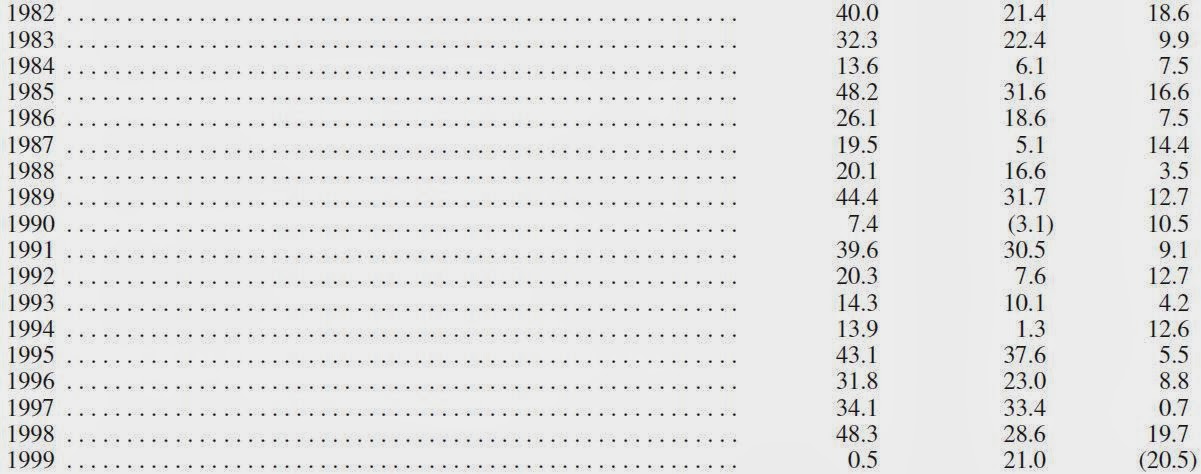



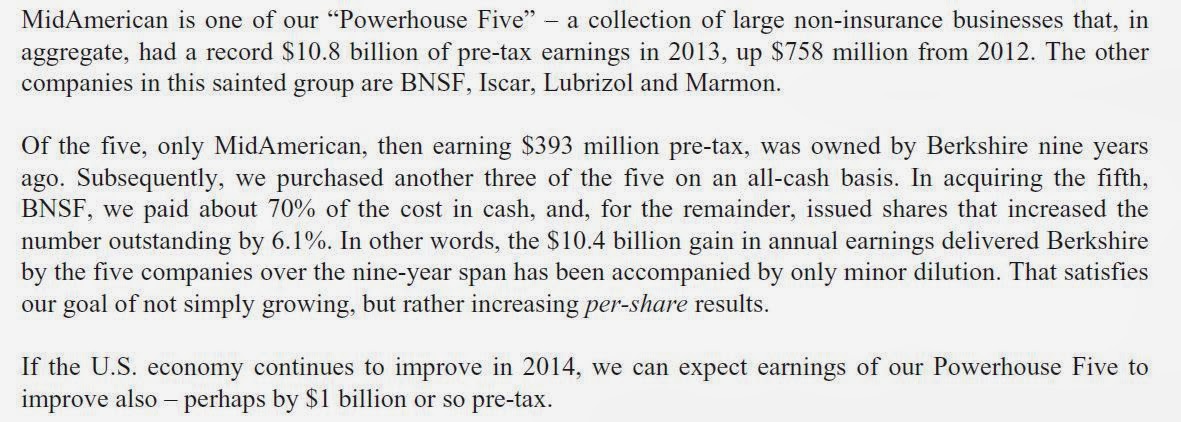
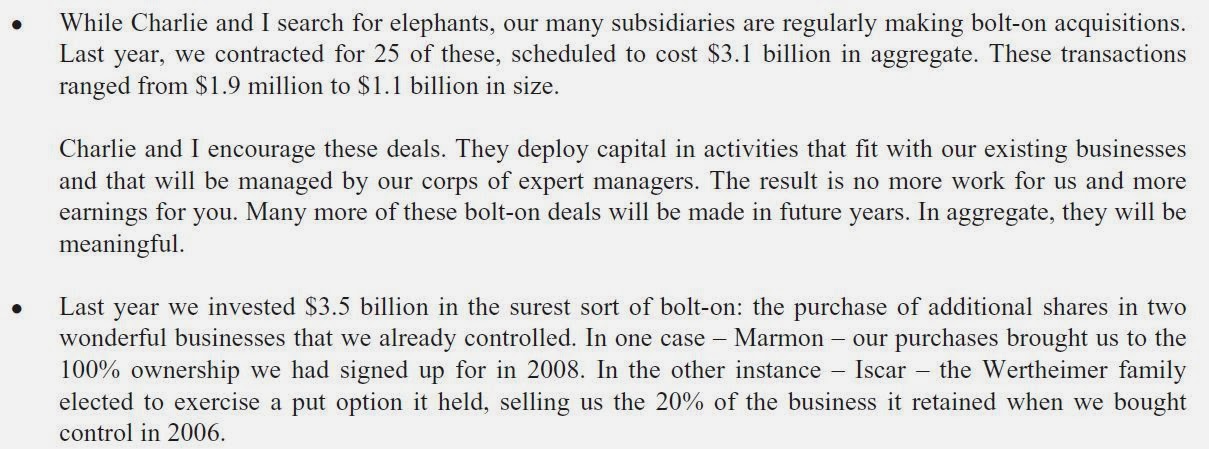








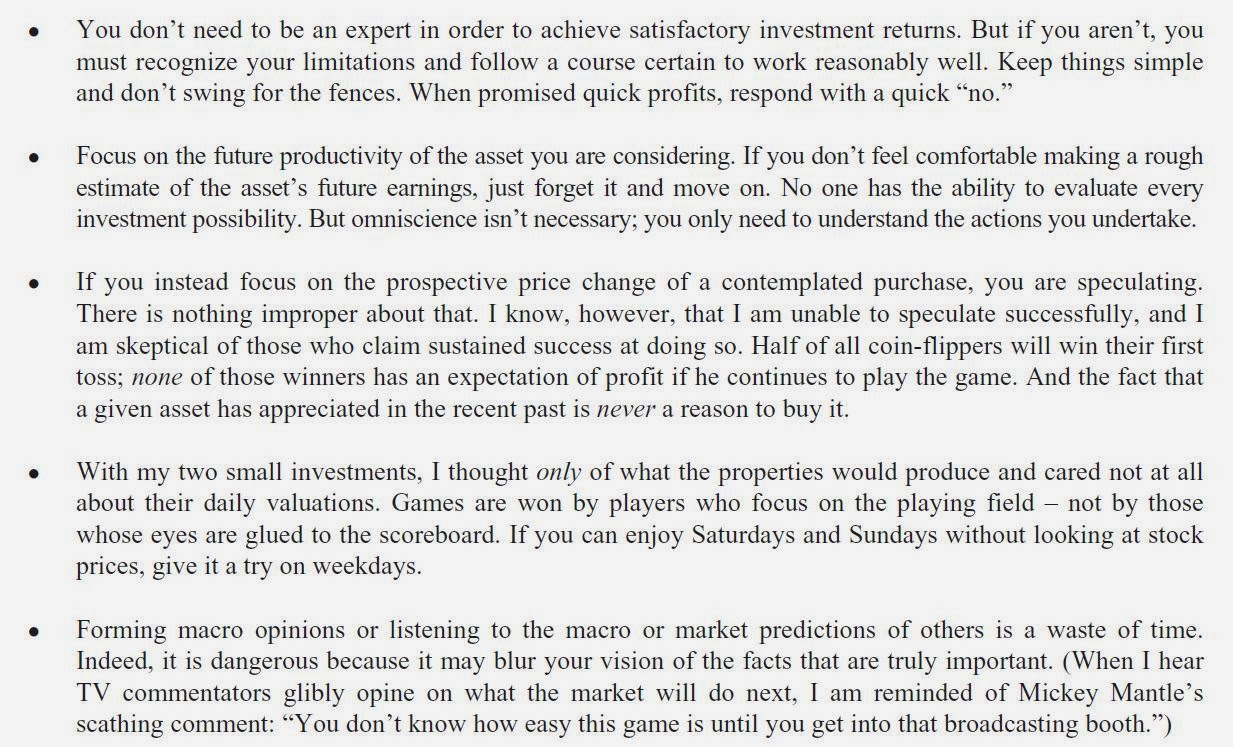
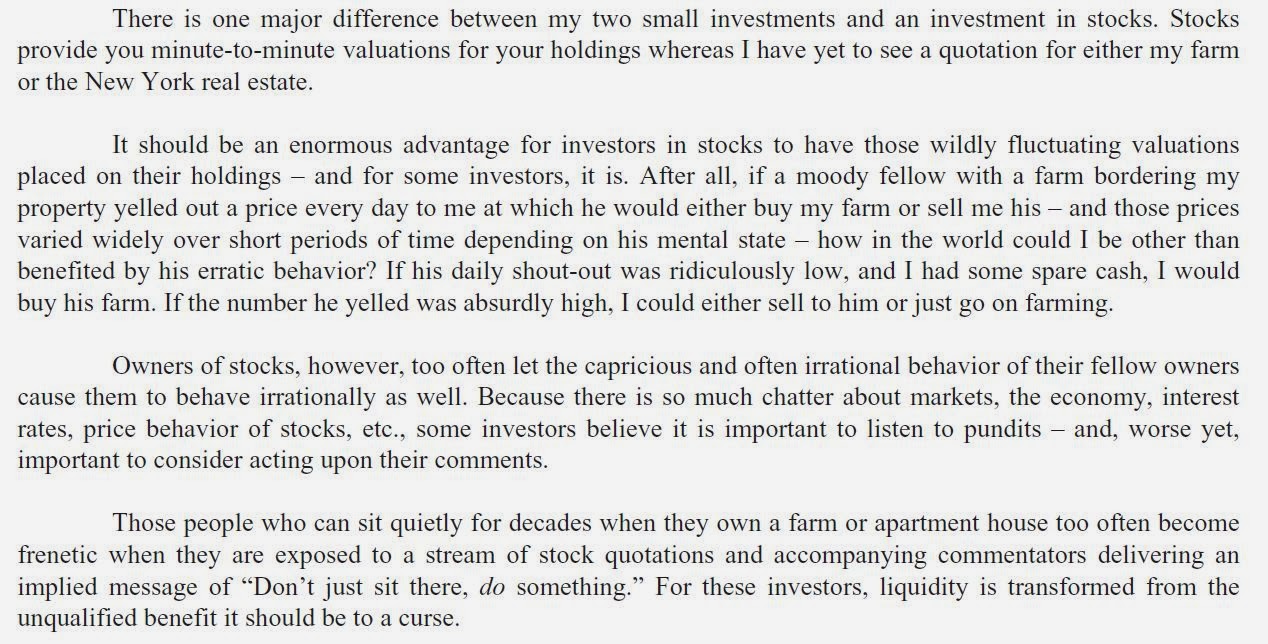



The under-performance isn't really surprising when you look at two of the biggest holdings, Coca Cola and P&G, which where invested in a long time ago and have been fully valued for quite a while. You can't really expect much growth from them. Also KO is the main reason Buffett beat the market in the 90s, its stock soared to a P/E ratio of like 40-50 and a third of his portfolio was in it.
But are they really his biggest "holdings"? It seems like his biggest holdings would be his complete ownership of GEICO or BNFC. This is why it's almost impossible to properly put a value on BRK. We don't know what the value of those stand alone companies are. We can attempt to come up with some book value accounting figure involving assets and liabilities, but we don't really have any idea what BRK could actually get for GEICO if it put it on the market for a buyer and future potential earnings are taken into consideration. Thus the "intrinsic value" of the BRK that Buffet mentioned in his letter. We just desperately cling to his publically traded equities as an attempt to judge how he's "performing", because we can actually look up on the ticker and see what he could get for those assets if he sold them at this moment.
Well, you can use Progressive as a GEICO comp as they are a pure auto insurer. There are other publicly listed railroads for BNI comp, so you can estimate what they are worth. If you google, you can find some sum-of-the-parts analysis based in this sort of thinking.
a shameless leecher here: which companies' ceo do you know of, that actually read n finished the book "double your profits" =)?
Well, we know the folks at 3G Capital so I'm sure Buffett and many of his CEOs probably read it. Other than that, someone said in an Amazon review that Sandy Weill handed this book out to senior managers after the Travellers merger, so it's highly likely that Dimon and people who work (and have worked) with him have read it. Otherwise, this is also probably a handbook for private equity, so CEOs that come from or work with private equity are also likely to have read it.
Otherwise, I have no idea!
Have you done any research on thrift conversions and performance? Interesting strategy.
No, not really. I've looked at a few but they all seem to have such low ROE's and I don't understand really the path to a higher ROE. I know there are some situations overcapitalized with intent to change that. And I know I should look more there, but I haven't done much work in that area…
Nice article with a great perspective.
Here's a link to the partnership and Berkshire letters from 1959-1977. Thanks for your insightful posts. I eagerly await them!
http://www.rbcpa.com/WEB_letters/WEB_Letters_pre_berkshireTURNEDOFF.html
Hi,
Thanks for that. I have the partnership letters but never saw the 1965-1977 BRK letters (which I got in that book).
Hi KK,
Great blog. I´m a long time follower of the blog and i would like to know a little more about your investing style. Like while in the value camp you tend to be more of a buy and hold investor or you tend to trade more actively around your positions and things like that. Thank you very much. Maybe some day you can write a post with more details of your investing style.
Hi,
Thanks for our interest, but I sort of like studying the investment style of others (who are more successful). I do tend to trade a little bit more than the people I talk about, but for the most part I try to do something that is a combination of the people I talk about. Some of the old partnership years Buffett, Greenblatt's Stock Market Genius book-type stuff, and some shorting now and then etc…
Hi KK,
I'm very new to investing and I found the above a great read, very easy to understand with lots of links for me to follow up on. Can I ask you a quick question because I'll never know if I get this wrong.
When Buffet mentions his advice for his trustee: Put 10% of the cash in short-term government bonds and 90% in a very low-cost S&P 500 index fund (he suggests Vanguards).
By any chance would you have link or ticker for that Vanguard fund so I could try and follow his advice please?
As mentioned I'm very new to investing so I would like to have 90% in an index fund for long term investing with 10% for playing with on penny stocks. At the moment I'm enjoying following why certain stocks go up and down and the financials behind the numbers.
Again thanks for blogging its very interesting following your posts, I feel I'm learning a lot.
Adrian
Here's the index fund: http://quotes.morningstar.com/fund/VFINX/f?t=VFINX
I don't know your financial situation, but Buffett recommends 10% cash, not penny stocks. That's a big difference. But if you are young, still working and have an income, I suppose you can play (speculate) with 10%… (even though I am not a fan of penny stocks, unless you do a lot of research on your own).
KK- great post. Thanks for posting.
I thought the picture was interesting because it showed the office is around 2/3 female.